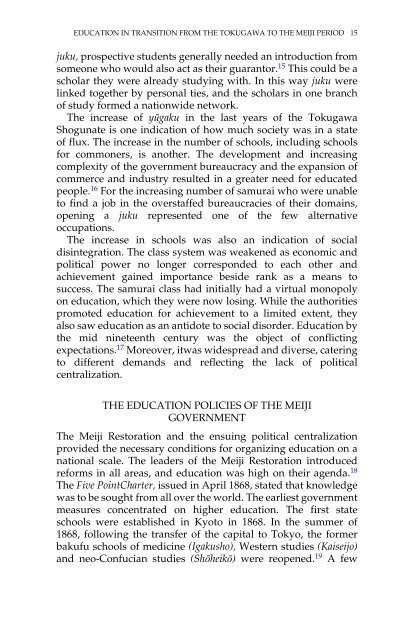Private Academies of Chinese Learning in Meiji Japan: The Decline ...
Private Academies of Chinese Learning in Meiji Japan: The Decline ...
Private Academies of Chinese Learning in Meiji Japan: The Decline ...
You also want an ePaper? Increase the reach of your titles
YUMPU automatically turns print PDFs into web optimized ePapers that Google loves.
EDUCATION IN TRANSITION FROM THE TOKUGAWA TO THE MEIJI PERIOD 15juku, prospective students generally needed an <strong>in</strong>troduction fromsomeone who would also act as their guarantor. 15 This could be ascholar they were already study<strong>in</strong>g with. In this way juku werel<strong>in</strong>ked together by personal ties, and the scholars <strong>in</strong> one branch<strong>of</strong> study formed a nationwide network.<strong>The</strong> <strong>in</strong>crease <strong>of</strong> yūgaku <strong>in</strong> the last years <strong>of</strong> the TokugawaShogunate is one <strong>in</strong>dication <strong>of</strong> how much society was <strong>in</strong> a state<strong>of</strong> flux. <strong>The</strong> <strong>in</strong>crease <strong>in</strong> the number <strong>of</strong> schools, <strong>in</strong>clud<strong>in</strong>g schoolsfor commoners, is another. <strong>The</strong> development and <strong>in</strong>creas<strong>in</strong>gcomplexity <strong>of</strong> the government bureaucracy and the expansion <strong>of</strong>commerce and <strong>in</strong>dustry resulted <strong>in</strong> a greater need for educatedpeople. 16 For the <strong>in</strong>creas<strong>in</strong>g number <strong>of</strong> samurai who were unableto f<strong>in</strong>d a job <strong>in</strong> the overstaffed bureaucracies <strong>of</strong> their doma<strong>in</strong>s,open<strong>in</strong>g a juku represented one <strong>of</strong> the few alternativeoccupations.<strong>The</strong> <strong>in</strong>crease <strong>in</strong> schools was also an <strong>in</strong>dication <strong>of</strong> socialdis<strong>in</strong>tegration. <strong>The</strong> class system was weakened as economic andpolitical power no longer corresponded to each other andachievement ga<strong>in</strong>ed importance beside rank as a means tosuccess. <strong>The</strong> samurai class had <strong>in</strong>itially had a virtual monopolyon education, which they were now los<strong>in</strong>g. While the authoritiespromoted education for achievement to a limited extent, theyalso saw education as an antidote to social disorder. Education bythe mid n<strong>in</strong>eteenth century was the object <strong>of</strong> conflict<strong>in</strong>gexpectations. 17 Moreover, itwas widespread and diverse, cater<strong>in</strong>gto different demands and reflect<strong>in</strong>g the lack <strong>of</strong> politicalcentralization.THE EDUCATION POLICIES OF THE MEIJIGOVERNMENT<strong>The</strong> <strong>Meiji</strong> Restoration and the ensu<strong>in</strong>g political centralizationprovided the necessary conditions for organiz<strong>in</strong>g education on anational scale. <strong>The</strong> leaders <strong>of</strong> the <strong>Meiji</strong> Restoration <strong>in</strong>troducedreforms <strong>in</strong> all areas, and education was high on their agenda. 18<strong>The</strong> Five Po<strong>in</strong>tCharter, issued <strong>in</strong> April 1868, stated that knowledgewas to be sought from all over the world. <strong>The</strong> earliest governmentmeasures concentrated on higher education. <strong>The</strong> first stateschools were established <strong>in</strong> Kyoto <strong>in</strong> 1868. In the summer <strong>of</strong>1868, follow<strong>in</strong>g the transfer <strong>of</strong> the capital to Tokyo, the formerbakufu schools <strong>of</strong> medic<strong>in</strong>e (Igakusho), Western studies (Kaiseijo)and neo-Confucian studies (Shōheikō) were reopened. 19 A few













